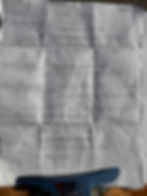Found a Van Gogh in the Attic
- Chuck Bueter
- Jul 23
- 2 min read
Updated: Jul 29
I found the equivalent of a Starry Night by Van Gogh while preparing for a survey of the night sky. Perhaps not in money terms, but in serendipitous discovery of a lost piece of work.
A Sky Quality Meter (SQM) is a light meter used to quantify how dark the sky is. On July 22, 2025, I gathered a few SQMs from a drawer when I noticed one SQM was in a plastic bag. I remember I had loaned the SQM out to a curious friend who wanted to check it out for herself to see what the device revealed about the night sky around her. What I hadn't noticed--or at least respected--upon her returning the SQM was the folded paper inside the bag.
For my July night's survey around New Carlisle, IN, I wanted to see if the limiting magnitude above the region had brightened since it was rezoned to encourage development on mostly rural land. The area is about to be impacted significantly as industry ramps up rapidly, so I wanted to reaffirm its status. Unfortunately, in a previous 2018 survey using SQMs I failed to record a visual limiting magnitude using the known brightness of stars within given constellations. I didn't have a baseline value from 2018 to which I could compare 2025 observations.
That's when Van Gogh appeared.
In the plastic bag, Debra DuRall had placed both her SQM readings and her limiting visual magnitude observations from sky surveys she did June 13, 2018 and July 12, 2018. Masterful artwork and science--reclaimed!

When we met on July 22, 2025, to re-survey the region, I acknowledged my shortcoming, both for not noticing she had done the work and for not thanking her for it. That night we drove around together and surveyed anew, knowing we had her baseline data against which we could compare the 2025 results.
DuRall's SQM readings with the Sky Quality Meter from July 2018 averaged 20.15 magnitudes per square arcsecond. Her limiting magnitude observations suggest the faintest stars were magnitude= 4.7. She did not record any stars with magnitude=4.8 or fainter. DuRall's 2018 data and observations are shown here for the record.


























